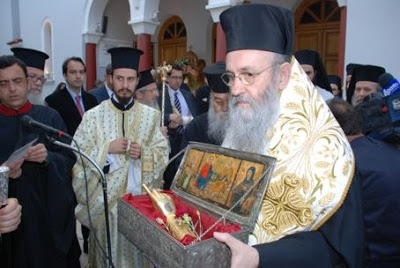To Search Is To Find
I understand that the veneration of the relic of a Saint allows us to pay respect as we commemorate the life of the Saint and request for his/her intercession for our petitions.
But I find it creepy to think of a body of a Saint being divided to be distributed into different monasteries for relic purposes. Why do they have to do that? Can’t we just leave the body as intact as possible and respect it the best way we could?

Veneration of the relic of the
right hand of the Holy Hieromartyr Polycarp, Bishop of Smyrna, Nafpaktos, West Greece, May 2, 2009
Thank you for your sharing. You write that you “find it creepy” which is really an emotional response to what you have seen happening to bodies of deceased persons, in this case, the saints.
The veneration of relics of the saints is found in the early history of the Church. A letter written by the faithful of the Church in Smyrna in the year 156 provides an account of the death of St. Polycarp, their bishop, who was burned at the stake. The letter reads, “We took up the bones, which are more valuable than precious stones and finer than refined gold, and laid them in a suitable place, where the Lord will permit us to gather ourselves together, as we are able, in gladness and joy, and to celebrate the birthday of his martyrdom.”
The Church strived to keep the use of relics in perspective. In his Letter to Riparius, St. Jerome (d. 420) wrote in defense of relics: “We do not worship, we do not adore, for fear that we should bow down to the creature rather than to the Creator, but we venerate the relics of the martyrs in order the better to adore Him whose martyrs they are.”
The Council of Trent (1563) defended invoking the prayers of the saints, and venerating their relics and burial places: “The sacred bodies of the holy martyrs and of the other saints living with Christ, which have been living members of Christ and the temple of the Holy Spirit, and which are destined to be raised and glorified by Him unto life eternal, should also be venerated by the faithful. Through them, many benefits are granted to men by God.”
We live in faith in our future resurrection which is not resuscitation, but a new way of being human. How? We don’t really know but we do know that the dead Jesus was raised to new life. “See, touch me, I am not a ghost” and “have you anything here to eat”.
So, let us pause for a moment. Perhaps in our technological age, the whole idea of relics may seem strange and dividing them up may even be stranger. Remember, all of us treasure things that have belonged to someone we love– a piece of clothing, another personal item, or a lock of hair. Those “relics” remind us of the love we continue to share with that person while he or she was still living and even after death. We are very proud to say, “This belongs to my mother,” for instance. Our hearts are torn when we think about disposing of the very personal things of a deceased loved one.
So, sharing the relics is a concession to our humanity which needs reminders, which thrives on memory. It seems to me that thinking that God will join our tibia, which is in one place, and our arm, which is in another place, is a crude way of understanding the resurrection of our bodies. We just don’t know how God brings our resurrection about. St. John wrote in his first letter (3:1-2):
Think of the love that the Father has lavished on us,
by letting us be called God's children;
and that is what we are.
Because the world refused to acknowledge him,
therefore it does not acknowledge us.
My dear people, we are already the children of God
but what we are to be in the future has not yet been revealed;
All we know is, that when it is revealed,
we shall be like him because we shall see him as he really is.
Thank you for your inquiry. I hope this may be of some help to you.
*You may also want to watch the youtube video of Bishop Robert Barron on Catholic Relics.

